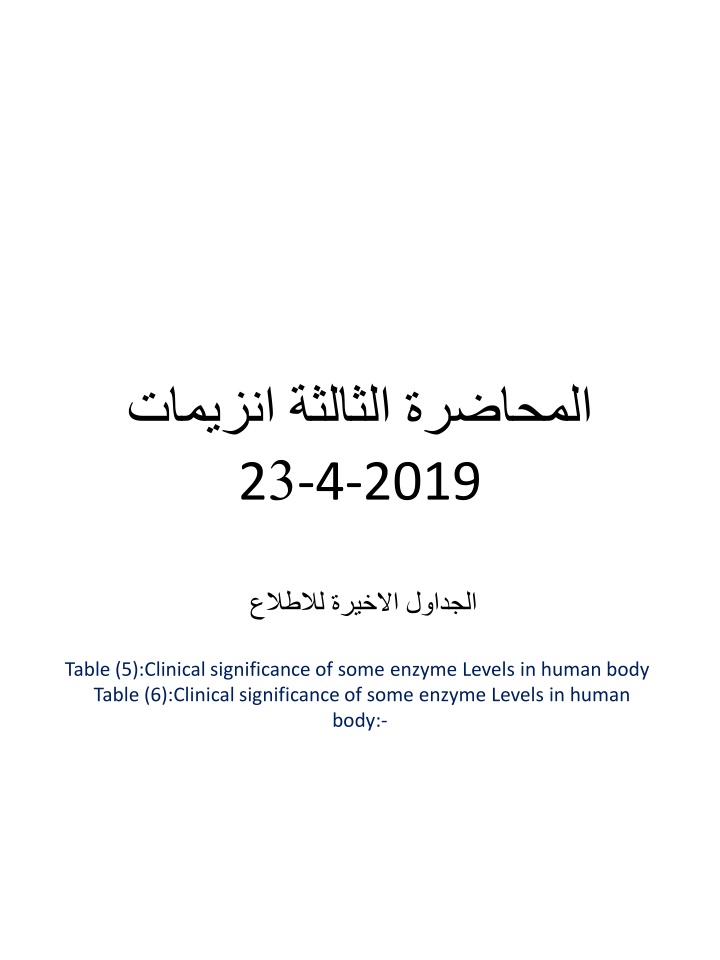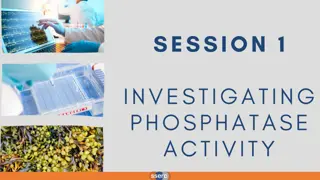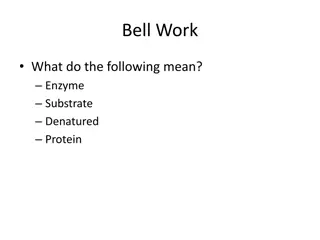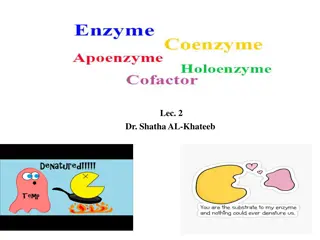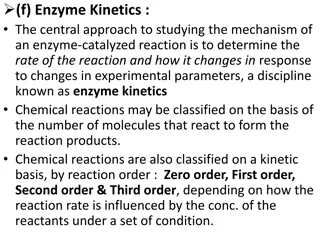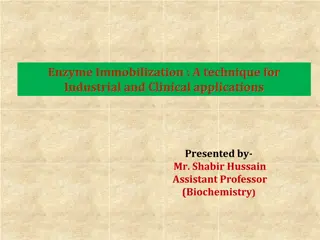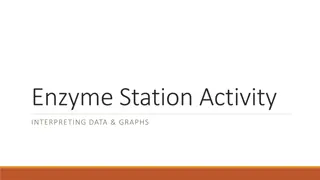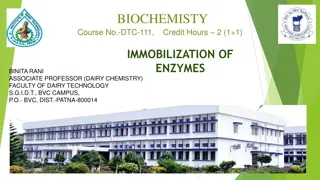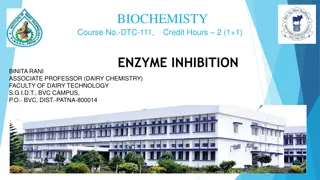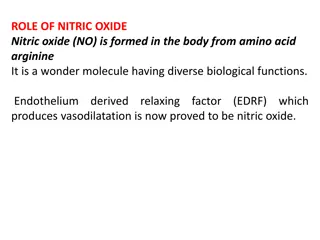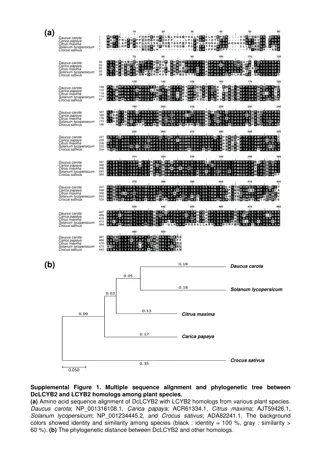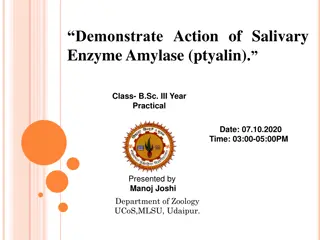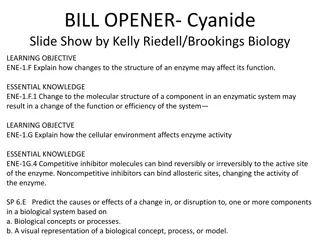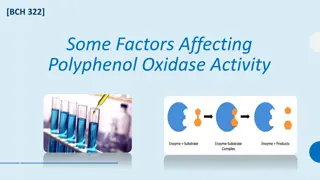Clinical Significance of Enzyme Levels in Human Body
The Michaelis-Menten equation describes the relationship between reaction velocity and substrate concentration in enzyme kinetics. Understanding the Michaelis-Menten constant (Km) is crucial in measuring enzyme efficiency. High blood pressure and heart attack are linked to enzyme functions such as renin's involvement in the Renin-Angiotensin system. Explore the impact of enzymes on various diseases and the importance of enzyme kinetics in medical research.
Download Presentation

Please find below an Image/Link to download the presentation.
The content on the website is provided AS IS for your information and personal use only. It may not be sold, licensed, or shared on other websites without obtaining consent from the author.If you encounter any issues during the download, it is possible that the publisher has removed the file from their server.
You are allowed to download the files provided on this website for personal or commercial use, subject to the condition that they are used lawfully. All files are the property of their respective owners.
The content on the website is provided AS IS for your information and personal use only. It may not be sold, licensed, or shared on other websites without obtaining consent from the author.
E N D
Presentation Transcript
23-4-2019 Table (5):Clinical significance of some enzyme Levels in human body Table (6):Clinical significance of some enzyme Levels in human body:-
Enzyme Kinetic The Michaelis-Menten equation What is Michaelis-Menten equation? Definition: The Michaelis-Menten equation describe how reaction initial velocity V varies with substrate concentration[S], by the following reaction: K K E + S [ES] complex E + P K K E is an enzyme while [S] is a substrate & P is a product. Where K ,K are forward reaction rate constant. Where K ,K are reverse reaction rate constant. Vmax V Rate of reaction. [S] concentration. Fig (10):- Plot for determination of [S], V, & Vmax. Directly proportional ( linear curve). THE MICHALIS-MENTON EQUATION IS: VMAX . [S] V = KM + [S] Km is the substrate concentration, at which V= Vmax When [S] = Km substitution of Km for [S] in the Michaela's Mentone equation yields:- V= Vmax . Fig (11):-Plot for determination of Km = Mikhail's Mentone constant & Vmax. Km is the substrate concentration at which V= Vmax reaction velocity on a function of [S] to the enzyme by Mikhail's Mentone equation. ( sigmoidal curve).
Michalis-Menton Constant Km = Michalis-Menton Constant is very important to measure enzyme efficiently to transform a substrate into product. If Km numerically small (low) reflects a high affinity of the Enzyme to bind substrate by diffusion of substrate into the active site, while if Km numerically high reflects a low affinity of the Enzyme to substrate concentration, e.g. Km of glucokinase is 10 mmole/L & Km of hexokinase is 0.05 mmole/L, indicate an increased rate of binding or affinity for Hexokinase for glucose than glucokinase. The Relation of Enzyme & Some Diseases: High Blood Pressure disease (Hypertension): High blood pressure(HBP) means the pressure in your arteries is higher than it should be. Normal blood pressure is below 120/80 mm Hg. High blood pressure usually has no signs or symptoms. That s why it is so dangerous. But it can be managed. When the heart beats, it creates pressure that pushes blood through a network of tube-shaped blood vessels, which include arteries, veins and capillaries. Increased blood pressure(HBP) cause Heart Attack due to blocking blood flow to the heart causing Heart Enlargement. Renin, is an enzyme, called Angiotensinogenase, its a protease enzyme, which regulates the body's water balance and blood pressure level. Thus, it regulates the body's mean arterial blood pressure. The Relation of Enzyme & Some Diseases: Heart Attack at (HBP): Due to blocking blood flow to the heart causing Heart Enlargement
Renin-Angiotensin system What is the function of Renin ? Renin activates the Renin-Angiotensin system, by cleaving Angiotensinogen (AGT), produced by the liver, to yield Angiotensin I, which is further converted into Angiotensin II, by Angiotensin Converting Enzyme 1 (ACE). Angiotensin II then constricts blood vessels, increases the secretion of aldosterone, and stimulates the hypothalamus to activate the thirst reflex, each leading to an increase in blood pressure. Renin's primary function is cause an increase in blood pressure. . For this reason, drugs known as ACE inhibitors (Captopril) are used to lower blood pressure Fig(13). The function of Angiotensin-Converting Enzyme(ACE): 1-Angiotensin-Converting Enzyme, ACE is a zinc metalloenzyme. The zinc ion Zn is essential to its activity (hydrolysis). Therefore, ACE can be inhibited by a pharmaceutical drug (Captopril) for treatment of cardiovascular diseases. 2-ACE is a central component in the plasma which requires chloride ion for its activation, and in controlling blood pressure, it regulates the volume of fluids in the body. ACE converts the hormone angiotensin I to the active vasoconstrictor angiotensin II, so ACE indirectly increases blood pressure by causing blood vessels to constrict. For this reason, drugs known as ACE inhibitors (Captopril) are used to lower blood pressure Fig(13). Captopril drug inhibitor. Fig(13):Feedback Captopril drug:- (ACE) enzyme is inhibited, by Captopril to give the efective product Angiotensin II. inhibition, by
Enzyme Cascades Enzyme cascades consist of a series of enzymes that sequentially activate each other, usually by covalent modification. Enzyme cascades amplify a weak regulatory signal so that it has a strong effect on a biochemical reaction. The first enzyme in the cascade is activated by the initial regulatory signal, example (Drugs as hormone initiator). Hormones which secreted in the blood stream where they travel through and effect on the target cells), and Blood clotting is mediated by a cascade of proteolytic activation that assure a rapid and amplified response to trauma, the last enzyme in the cascade controls is the regulated process. Hormone 1 Enzyme 1(inactive) 1 Enzyme 1 (active) 100 Enzyme 2 (inactive) 100 Enzyme 2 (active) 10,00 Enzyme 3 (inactive) 10,00 Enzyme 3(active) 106 B 106 A Figure-2 :- A hypothetical enzyme cascade. Blood Clotting Formation By Enzyme Cascades :- Bleeding are problems may have origin in naturally occurring. Blood clotting is mediated by a cascade of proteolytic activation that assure a rapid and amplified in response to trauma. So blood clotting is activated by enzymes secreted by the cell at the damaged site by involving series of proteolytic reactions that result in formation of Prothrombin activator complex by converting Prothrombin into Thrombin. Thrombin cleaves four peptide bonds in Fibrinogen to produce Fibrin.
Blood Clotting Formation By Enzyme Cascades :- Bleeding are problems may have origin in naturally occurring. Blood clotting is mediated by a cascade of proteolytic activation that assure a rapid and amplified in response to trauma. So blood clotting is activated by enzymes secreted by the cell at the damaged site by involving series of proteolytic reactions that result in formation of Prothrombin activator complex by converting Prothrombin into Thrombin . Thrombin cleaves four peptide bonds in Fibrinogen to produce Fibrin. Prothrombin Thrombin Fibrinogen Fibrin Fibrin threads . When Fibrinogen has been converted to Fibrin, the clot that forms is a polymerized Fibrin threads that become attached to blood cells, blood vessels walls, and plasma proteins. Fibrin threads is unstable so the enzyme Transglutaminase stabilized the Fibrin clot by producing covalent cross-linkages between Fibrin threads in the clot. Certain natural proteins and Vitamin K as well as synthetic antagonists drugs are effective in controlling this bleeding. The following figure(14) below indicate that Prothrombin activator complex Prothrombin (inactive) Thrombin (active) Fibrinogen (inactive) Fibrin (active) Fibrin Threads Fibrin Fibrin Fibrin Fibrin Figure (14): Blood Clotting formation
Inflammation relief Aspirin is used for inflammation, pain, fever, and blood thinner. The covalent bond formed between Aspirin and an enzyme called cyclooxygenase or (COX) casing deactivation of this enzyme. Cyclooxygenase or (COX) is a key enzyme involved at inflammation and activate the formation of blood clotting (by platelets and red blood cells in blood stream after injury), or stimulate the hypothalamus to increase body Temperature. Inactivation of this enzyme cause a pain relief or decrease the body Temperature figure (14). About 2.5 million people/ Year are used Aspirin. Aspirin has disappeared from the bloodstream (after about 15 minutes). Figure (14):The effect of Aspirin structure on Prostaglandin synthase as a pain relief. Genetic Diseases Wilson s Disease It is a rare genetic disease, that require the patient to inherit the gene ATP7B, this genetic disorder prevent the body from expelling excess Copper, and causing marked increase of copper concentration in the liver, brain, kidneys, and eyes. So Wilson s disease is biochemically characterized by reduced serum concentrations of copper and Ceruloplasmin enzyme, and clinically by signs of hepatic and neurologic dysfunction. Treatment involves by using Penicillamine to remove of excess copper, It is readily absorbed by gastrointestinal tract and rapidly excreted in the urine. The chance of getting this disease is about 1 in 40,000 people over the world. mhtml:file://C:\Users\HP\Desktop\CERUPLASMIN\Ceruloplasmin%20-%20Wikipedia,%20the%20free%20encyclopedia.mht!http://upload.wikimedia.org/wikipedia/commons/thumb/2/2b/Protein_CP_PDB_1kcw.png/250px-Protein_CP_PDB_1kcw.png Fig.(16): Ceruloplasmin (ferroxidase): (Ceruloplasmin structure is one of the blood plasma minor proteins which is responsible of Copper transfer in blood.).
Clinical significance of enzyme levels:- In clinical practice, the enzyme concentration monitoring is performed on patients These levels can be of great importance in diagnosis of many diseases & in monitoring of tissue damage. Table (5):Clinical significance of some enzyme Levels in human body:- Lactate dehydrogenase isoenzymes (LDH) Type Location 1 LDH1 Heart muscle, RBC, kidney Liver disease 2 LDH2 Heart muscle, RBC, kidney Liver disease 3 LDH3 Brain and kidney 4 LDH4 Liver and skeletal muscle Heart attacks 5 LDH5 Liver and skeletal muscle Heart attacks Creatinine Phosphokinase (CPK) isoenzymes in Myocardial infarction Type Composition Location 1 CK1 BB Brain and skeletal muscle 2 CK2 MB Myocardial muscle 3 CK3 MM Skeletal muscle and myocardial muscle
Clinical significance of enzyme levels:- In clinical practice, the enzyme concentration monitoring is performed on patients. These levels can be of great importance in diagnosis of many diseases & in monitoring of tissue damage. Table (6):Clinical significance of some enzyme Levels in human body:- Enzyme Enzyme Levels increased in Enzyme Location 1 Alkaline phosphatase (ALP) Liver Cancer, Jaundice Liver& Bone. 3 Angiotensin II Intravenous. Hypertension 4 Glutamic oxalocetic transamiase (GOT) Infectious hepatitis, myocardial infarction. Heart & Liver. 5 Glutamic pyruvic transamiase (GPT) Liver. Infectious hepatitis. 6 Heart & Liver. Lactate dehydrogenase (LDH) Myocardial infarction, Leukemia
